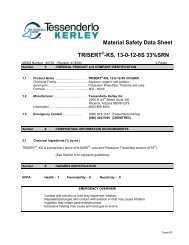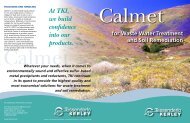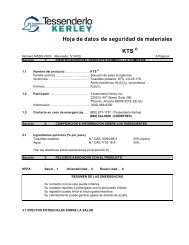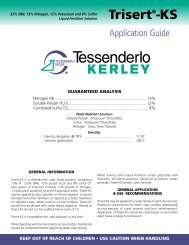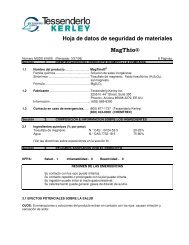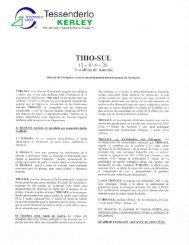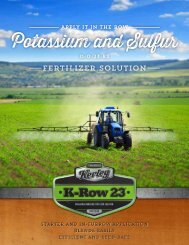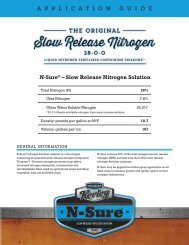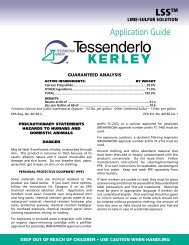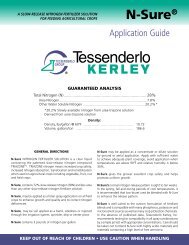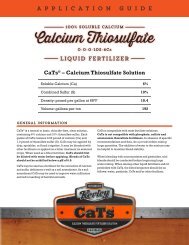TRISERT®-CB Application Guide - Tessenderlo Kerley
TRISERT®-CB Application Guide - Tessenderlo Kerley
TRISERT®-CB Application Guide - Tessenderlo Kerley
Create successful ePaper yourself
Turn your PDF publications into a flip-book with our unique Google optimized e-Paper software.
Foliar Fertilizer Solution<br />
26-0-0+0.5B<br />
CAUTION — MAY CAUSE IRRITATION<br />
PRECAUTIONARY STATEMENTS<br />
Avoid prolonged or repeated contact with eyes, skin and<br />
clothing. Chemical goggles or a full face shield should be<br />
worn. To protect skin wear appropriate protective equipment,<br />
such as rubber or plastic aprons, rubber gloves and boots.<br />
Avoid breathing mist or vapor. Keep containers closed. Wash<br />
thoroughly after handling. May cause gastrointestinal distress<br />
if swallowed.<br />
FIRST AID<br />
In case of contact with eyes, immediately flush eyes with water<br />
for at least 15 minutes. Seek immediate medical attention if<br />
irritation occurs. In case of skin contact, flush skin with water.<br />
If irritation occurs, seek immediate medical attention. Remove<br />
and wash contaminated clothing before reuse. If swallowed,<br />
give large amounts of water and induce vomiting by touching<br />
back of throat with finger unless unconscious. Seek immediate<br />
medical attention.<br />
HANDLING AND STORAGE<br />
Minimize skin exposure. Store mini‑bulks and smaller<br />
containers out of the sun in an area of moderate temperature.<br />
Do not reuse containers. Avoid containers, piping or fittings<br />
made of copper‑containing alloys or galvanized metal. Do Not<br />
store at temperatures below 0 ° F., as crystallization may occur.<br />
Dispose of containers in accordance with local regulations<br />
and requirements.<br />
IN CASE OF SPILL<br />
Contain spill and maximize recovery. Keep spill out of water<br />
sources. Exercise caution in area of spill for slippery conditions.<br />
Dispose of spilled material in accordance with regulatory<br />
requirements.<br />
PHYTOTOXICITY<br />
Plant and leaf injury may occur on some crops when certain<br />
weather and growing conditions are present. The user assumes<br />
all risks of use and handling.<br />
Trisert ®<br />
-<strong>CB</strong><br />
<strong>Application</strong> <strong>Guide</strong> for Agriculture Crops<br />
WARNING: TRISERT‑<strong>CB</strong> contains boron which may cause<br />
injury to crops other than those recommended. All applications<br />
should be at the recommended rates and timing of application.<br />
Contact your fluid fertilizer dealer or <strong>Tessenderlo</strong> KERLEY for<br />
additional information.<br />
Before handling this product, consult the Material Safety Data<br />
Sheet for handling, safety and first aid information.<br />
Follow directions carefully, including precautions for safe handling.<br />
DIRECTIONS FOR USE<br />
TRISERT‑<strong>CB</strong> is a revolutionary foliar fertilizer that contains<br />
triazone, a patented, slow‑release nitrogen compound. TRISERT‑<br />
<strong>CB</strong> contains boron, an essential minor element.<br />
TRISERT‑<strong>CB</strong> may be applied either undiluted or diluted (with<br />
water) for aerial or ground application. Use sufficient carrier<br />
to adequately cover crop foliage.<br />
General recommendations are listed below.<br />
VEGETABLES RATE TIME OF APPLICATION<br />
(QTS/ACRE)<br />
Asparagus 6 ‑ 10 Beginning at mid‑fern development,<br />
then at 14 to 21 day intervals.<br />
Beans (Dry)<br />
single application 10 Early pod formation.<br />
multiple application 4 ‑ 6 Early flower and repeat in 10 to<br />
14 days.<br />
Beans (green, lima) 4 ‑ 6 Early flower and repeat in 7 to<br />
10 days.<br />
Broccoli 6 ‑ 10 First application after thinning, then<br />
3 weeks before head formation and<br />
repeat in 7 to 10 days.<br />
Cabbage 6 ‑ 10 First application after thinning,<br />
then early head formation and<br />
repeat after 14 to 21 days.<br />
KEEP OUT OF REACH OF CHILDREN • USE CAUTION WHEN HANDLING
VEGETABLES RATE TIME OF APPLICATION<br />
(QTS/ACRE)<br />
Cantaloupes 6 ‑ 10 Early flowering and repeat in 7<br />
to 10 days.<br />
Carrots 4 ‑ 6 When plants are 3 to 6 inches<br />
tall, repeat at three week intervals<br />
or as required.<br />
Cauliflower 6 ‑ 10 First application after thinning<br />
or transplant, other applications<br />
at early head set and repeat at<br />
10 to 14 day intervals.<br />
Celery 4 ‑ 6 When plants are 8 to 12 inches<br />
tall and repeat at 10 to 14 day<br />
intervals.<br />
Corn (Sweet) 4 ‑ 6 When plants are 12 to 24 inches<br />
high, then at tassel emergence<br />
and repeat after pollination.<br />
Cucumbers<br />
single application 10 ‑ 16 Early fruit set.<br />
multiple application 4 ‑ 6 Early flower and repeat at 10 to<br />
14 day intervals.<br />
Eggplant 4 ‑ 6 At bud stage and repeat at 10 to<br />
14 day intervals.<br />
Lentils 4 ‑ 6 Early flowering and repeat at<br />
10 to 14 day intervals.<br />
Lettuce 4 ‑ 6 After thinning, then at early head<br />
formation and repeat at 10<br />
to 14 day intervals.<br />
Okra 4 ‑ 6 At bud stage and repeat at 10 to<br />
14 day intervals.<br />
Onions 4 ‑ 6 Mid‑set development and repeat<br />
at 14 to 21 day intervals.<br />
Peas 4 ‑ 6 Early flowering and repeat in<br />
10 to 14 days.<br />
Peppers 4 ‑ 6 Early fruit set and repeat at<br />
10 to 14 day intervals.<br />
Spinach 6 ‑ 10 When sufficient foliage is present<br />
and repeat at 14 to 21 days.<br />
Squash 6 ‑ 10 Early fruit set and repeat at<br />
10 to 14 day intervals.<br />
Tomatoes (Process)<br />
single application 10 Apply 10 to 14 days after<br />
full bloom.<br />
multiple application 4 ‑ 6 At full bloom and repeat at 10<br />
to 14 day intervals until 2 weeks<br />
before harvest.<br />
VEGETABLES RATE TIME OF APPLICATION<br />
(QTS/ACRE)<br />
Tomatoes (Fresh)<br />
single application 10 Apply 10 to 14 days after full<br />
bloom.<br />
multiple application 4 ‑ 6 At full bloom and repeat at 10 to<br />
14 day intervals until harvest is<br />
near completion.<br />
Watermelons 6 ‑ 10 Early flowering and repeat in 7<br />
to 10 days.<br />
Other Crops 4 ‑ 6 When sufficient foliage is present,<br />
try on a small area until more<br />
experience and trials have been<br />
completed to determine if higher<br />
rate is desirable.<br />
FERTIGATION<br />
SPRINKLER IRRIGATION - Beginning at the 3rd to 4th leaf<br />
stage, apply 2 to 5 gallons per acre per application every 10 to 14<br />
days based on crop requirements.<br />
DRIP IRRIGATION - Apply 1 to 5 gallons per acre per application<br />
3 to 6 times during the growing season as needed.<br />
FRUITS/NUTS RATE TIME OF APPLICATION<br />
(QTS/ACRE)<br />
Almonds 6 ‑ 10 Full leaf. Repeat at early nut<br />
expansion.<br />
Apples 4 ‑ 6 Apply in a minimum of 100 gallons<br />
of water spray solution. Begin at<br />
first full leaf and apply as needed<br />
during the growing season.<br />
Apricots 4 ‑ 6 Prior to fruit set.<br />
Blueberries 6 ‑ 10 Early fruit set and repeat at early<br />
fruit color.<br />
Caneberries 4 ‑ 6 Prior to fruit set.<br />
Cherries 6 ‑ 10 Prior to fruit set.<br />
Citrus 6 ‑ 10 Early bloom and repeat after<br />
fruit set.<br />
Winter 12 ‑ 30 Apply in mid‑January and<br />
repeat as necessary.<br />
Cranberries 4 ‑ 6 Hook stage and repeat after<br />
fruit set.<br />
Filberts<br />
single application 10 ‑ 16 Early nut filling.<br />
multiple application 4 ‑ 6 Early leaf expansion and repeat<br />
at 14 to 21 day intervals.
FRUITS/NUTS RATE TIME OF APPLICATION<br />
(QTS/ACRE)<br />
Grapes<br />
Table 2 ‑ 4 Prior to fruit set.<br />
Raisin 2 ‑ 4 When sufficient foliage is present.<br />
Repeat as needed.<br />
Wine 2 ‑ 4 When sufficient foliage is present.<br />
Repeat as needed.<br />
Olives 4 ‑ 6 Early fruit development and<br />
repeat as needed.<br />
Peaches ‑ Nectarines 6 ‑ 10 Prior to fruit set.<br />
Pears 4 ‑ 6 Prior to fruit set or post‑harvest.<br />
Pecans 4 ‑ 6 Full leaf. Repeat at early nut<br />
expansion.<br />
Plums 6 ‑ 10 Prior to fruit set.<br />
Prunes 2 ‑ 4 Full leaf. Repeat as needed.<br />
Strawberries 2 ‑ 3 Early flowering and repeat every<br />
14 days through harvest. Initiate<br />
fall application when new growth<br />
reaches 3 inches in height.<br />
FERTIGATION<br />
SPRINKLER IRRIGATION ‑ Apply 2 to 5 gallons per acre per<br />
application every 10 to 14 days based on crop requirements.<br />
DRIP IRRIGATION ‑ Apply 1 to 5 gallons per acre per application 3 to<br />
6 times during the season when roots are actively growing as needed.<br />
FIELD CROPS RATE TIME OF APPLICATION<br />
(QTS/ACRE)<br />
Alfalfa 4 ‑ 6 Apply after each cutting when<br />
sufficient foliage is present.<br />
Canola 4 ‑ 8 Pre‑bloom.<br />
Corn 4 ‑ 6 When plants are 12‑24 inches<br />
high, then at tassel emergence<br />
and repeat after pollination.<br />
Corn (Seed) 4 ‑ 6 Before detasseling and repeat<br />
after pollination.<br />
Cotton<br />
Seedling‑ 3 ‑ 4 After first true leaves appear.<br />
After seedling 2 ‑ 4 May be applied in combination<br />
stage with crop protection<br />
chemicals and growth regulators.<br />
Boll 2 ‑ 4 Early boll formation and repeat<br />
development at 14 to 21 day intervals.<br />
Flax 6 ‑ 10 Early boll development.<br />
Grain Sorghum 4 ‑ 6 After pollination.<br />
FIELD CROPS RATE TIME OF APPLICATION<br />
(QTS/ACRE)<br />
Grass (Seed 10 ‑ 16 Seed head elongation.<br />
Production)<br />
Hops 4 ‑ 6 Before cone development.<br />
Peanuts<br />
single application 10 ‑ 16 Early pod development.<br />
multiple application 4 ‑ 6 Early bloom and repeat at 14 to 21<br />
day intervals until pods are filled.<br />
Potatoes<br />
single application 10 ‑ 16 Mid‑tuber development.<br />
multiple application 4 ‑ 6 Tuber initiation and repeat at 10<br />
to 14 day intervals until maximum<br />
tuber development has occurred.<br />
Rice 6 ‑ 10 Panicle initiation. Repeat as<br />
required.<br />
Small Grains 6 ‑ 10 Tiller to seed head formation.<br />
Soybeans 4 ‑ 6 Early flower and repeat in 14 to<br />
21 days.<br />
Sugar Beets 10 10 to 12 leaf and repeat at 20<br />
leaf stage.<br />
Sunflower 4 ‑ 6 When outer seeds start to fill,<br />
repeat in 10 to 14 days.<br />
Sweet Potatoes 4 ‑ 6 Tuber initiation and repeat at 10<br />
to 14 day intervals.<br />
Tobacco 6 ‑ 10 Plant bed stage to near maturity<br />
as needed to maintain crop<br />
growth and quality.<br />
FERTIGATION<br />
CENTER PIVOT ‑ Apply 3 to 5 gallons per acre per application as<br />
needed based on crop requirements<br />
DRIP IRRIGATION ‑ Apply 3 to 5 gallons per acre per application 3<br />
to 6 times during the growing season as needed.<br />
SPRINKLER IRRIGATION ‑ Beginning at the 3rd to 4th leaf stage,<br />
apply 3 to 5 gallons per acre per application every 10 to 14 days based<br />
on crop requirements.<br />
CHRISTMAS TREES, RATE TIME OF APPLICATION<br />
ORNAMENTAL & (QTS/ACRE)<br />
NURSERY STOCK<br />
4 ‑ 10*<br />
*A rate of 10 qts./acre is equivalent<br />
to 7.35 oz./1000 square ft.<br />
When sufficient foliage is present.<br />
TRISERT‑<strong>CB</strong>, has been applied<br />
undiluted to some types of<br />
ornamental and nursery stock.<br />
Since these plants vary widely in<br />
growth habit and leaf texture,<br />
some types are more susceptible<br />
to leaf or tip burn than others. It<br />
is recommended that the user try<br />
only a few plants at undiluted or<br />
concentrated rates and observe for<br />
a week before general applications<br />
are made.
Mixing Procedures When Tank Mixing TRISERT-<strong>CB</strong><br />
• Add 1/2 of total water to spray tank<br />
• Start circulating material in tank<br />
• Add recommended amount of TRISERT-<strong>CB</strong><br />
• Add compatible micronutrients<br />
• Add flowable materials<br />
• Add emulsifiables<br />
• Add any soluble powders and/or water soluble fertilizers.<br />
All should be pre‑dispersed in water before adding to the<br />
spray tank solution.<br />
• Complete filling of spray tank to desired volume and continue<br />
circulating prior to spray application.<br />
• Flush all spray and nurse equipment after usage.<br />
TRISERT‑<strong>CB</strong> may be applied with pesticide applications. In absence<br />
of specific information regarding compatibility, it is recommended<br />
that a jar test be utilized to determine specific compatibilities with<br />
pesticides and other nutrient sources.<br />
GOOD NITROGEN MANAGEMENT IS THE KEY<br />
Successful nitrogen application rates are dependent upon a number<br />
of factors, such as soil type, organic matter content, soil nitrate<br />
level, previous crop, irrigation or non‑irrigation, variety, planting<br />
date, etc. Unexpected weather variations make preplant and/or early<br />
season nitrogen application rates difficult to recommend. To achieve<br />
efficiency, nitrogen fertilizer use should be considered as a dependent<br />
production variable. Total nitrogen applied will depend upon the needs<br />
of the developing plant and those environmental factors responsible<br />
for the production system in each field.<br />
Soil test recommendations and specific nitrogen rates are usually<br />
for average conditions only. For efficient nitrogen use, use starter<br />
fertilizer, band applications during cultivation, and foliar applications<br />
of TRISERT‑<strong>CB</strong> as the plant’s needs dictate.<br />
TRISERT‑<strong>CB</strong> contains triazone, a new, patented, highly‑concentrated<br />
form of nitrogen in which three carbon atoms are joined by three<br />
nitrogen atoms to form a strong chemical bond. This bond provides<br />
for a slow nitrogen release, which results in less burn and better leaf<br />
absorption. Better absorption means better fertilizer performance<br />
and better crop yields.<br />
TRISERT and KTS are registered trademarks of <strong>Tessenderlo</strong> <strong>Kerley</strong>, Inc. USA<br />
P.O.Box 15627 • Phoenix, Arizona 85060 U.S.A.<br />
602-889-8300 • 800-525-2803<br />
e‑mail: info@tkinet.com • website: www.tkinet.com<br />
TECHNICAL DATA INFORMATION<br />
TRISERT-<strong>CB</strong> NITROGEN FOLIAR FERTILIZER SOLUTION WITH BORON<br />
(26-0-0+0.5B)<br />
PLANT NUTRIENT CONTENT<br />
Total Nitrogen (N), Wt.% 26.0 Min<br />
Boron (B) 0.5<br />
TYPICAL DISTRIBUTION OF NITROGEN FORMS,<br />
% OF TOTAL N<br />
Slow‑release Nitrogen (SRN) 33.0<br />
From Triazone Compounds 31.0<br />
From Other N Compounds 2.0<br />
Urea N 67.0<br />
TYPICAL PROPERTIES<br />
Specific Gravity, 60˚ /60˚F 1.223<br />
pH 8.7<br />
Salting‑Out Temperature, ˚F



